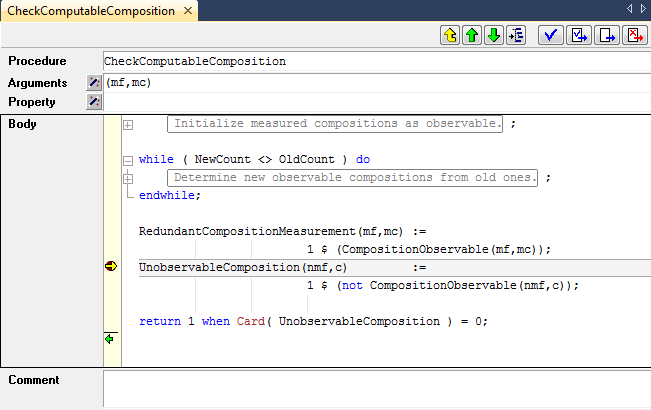Specifying the body
Statements
In the Body attribute of a procedure or function you can specify the
assignments,
calls to other procedures or functions in your model, and
flow control statements such as
for,whileorif-then-else
which perform the actual task or computation for which the procedure or function is intended. The precise syntax of all execution statements is discussed in detail in the AIMMS Language Reference book.
Automatic outlining
When you are constructing a procedure or function whose execution
consists of a large number of (nested) statements, it may not always be
easy or natural to break up the procedure or function into a number of
separate procedures. To help you maintain an overview of such large
pieces of execution code, AIMMS will automatically add outlining support
for common flow control statement and multiline comments. The minus
button  that appears in front of the statement allows you to
collapse the statement to a single line block and the and plus button
that appears in front of the statement allows you to
collapse the statement to a single line block and the and plus button
 allows you to expand the statement to its full extent again.
allows you to expand the statement to its full extent again.
Execution blocks
In addition, you can break down the body of a procedure or function into
manageable pieces using one or more execution blocks. Any number of
AIMMS statements enclosed between block and endblock keywords
can be graphically collapsed into a single block. The text in the single
line comment following the block keyword is used as display text for
the collapsed block.
An example of a procedure body containing two collapsed execution blocks is given in Fig. 27.

Fig. 27 Example of a procedure body with execution blocks
Identifier references
When you are entering statements into a body of a procedure or function, AIMMS can help you to add identifier references to the body quickly and easily:
you can drag and drop the names from the model tree into text
with the name completion feature you can let AIMMS complete the remainder of the name based on only the first characters typed.
The precise details of drag-and-drop support and name completion of identifiers are discussed in Working with trees and Identifier attributes.
Viewing identifier details
When you are entering the body of a procedure or function, you may want to review the attributes or current data of a particular identifier referenced in the body. AIMMS offers various ways to help you find such identifier details:
through a text based search in the model tree, you can locate the specific identifier node and open its attribute form (see Working with trees),
by clicking on a particular identifier reference in the body, you can open its attributes form through the Attributes item in the right-mouse pop-up menu,
you can locate the identifier declaration in the model tree through the Location in Model Tree item in the right-mouse pop-up menu, and
you can view (or modify) the identifier’s data through the Data item in the right-mouse pop-up menu (see Viewing and modifying identifier data).
Viewing procedure details
Similarly, while you are referencing a procedure or function inside the body of another procedure or function, AIMMS will provide prototype information of such a procedure or function as soon as you enter the opening bracket (or when you hover with the mouse pointer over the procedure or function name). This will pop up a window as illustrated in Fig. 28.

Fig. 28 Prototype info of a procedure
This tooltip window displays all arguments of the selected procedure or function, their respective data types, as well as their Input-Output status. The latter enables you to assess the (global) effect on the actual arguments of a call to the procedure.